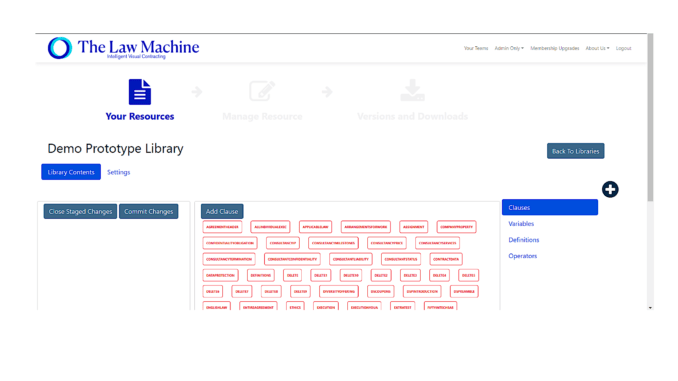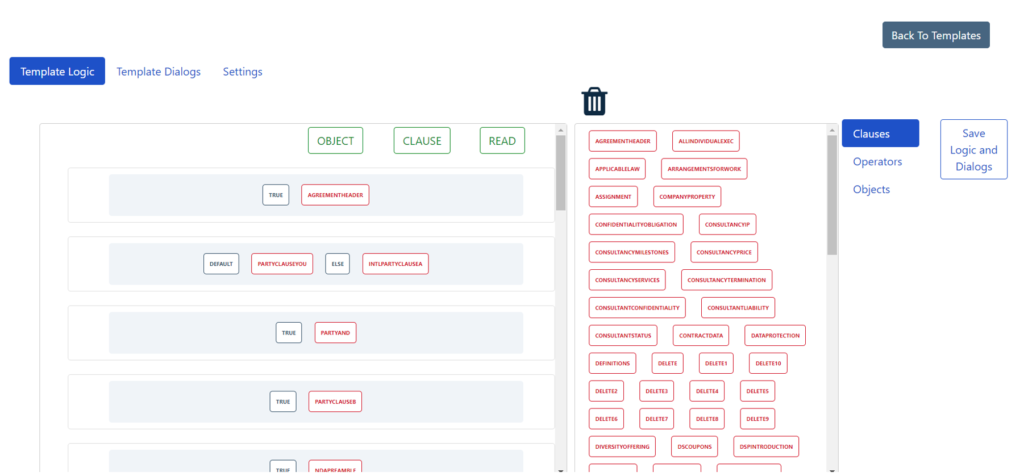
One legal tech startup that may help with the contract standardisation vs flexibility challenge is The Law Machine, which has atomised contracts into their constituent parts and then allows you to build the agreement you want from those fixed elements.
For example, if you want to build a new contract you can choose from an array of clauses and definitions displayed on the interface. You drag and drop the pieces into the document as you go along. Those elements can be edited, if it’s really needed, and then specific data for that agreement is added in, (see image below).
Of course, clause libraries are already a well-developed idea, but what stands out here is how the product is totally focused on the modular approach.

What this site also liked about it was the way it balanced standardisation with the need to be flexible. For example, a company could set up a ‘palette’ of clauses that are all standard, but it also wants its lawyers to be able to rapidly customise or expand a document if needed. With The Law Machine approach you can do this because you are not dealing with an entire document, but parts of one. That allows you to adhere to an organisation’s internal standards, or wider industry standards e.g. oneNDA, but also to have that extra ability to customise as you see fit by adding the parts from this pre-agreed palette that you want on a clause by clause basis.
Artificial Lawyer spoke to founder and lawyer, Andrew Stokes (pictured), about the startup.

- What made you come up with this idea?
A previous business idea of mine needed document automation, but the traditional document automation process looked horrible to me. I thought I could invent something better.
I set myself some design principles :
- Be as modular as possible – modularity helps you reuse content and automate processes. I created “fat” modular content libraries with a lot in them – obviously clauses, but also granular stuff like variables and defined terms.
- Thin templates – as little as possible in the templates, just the names of the clauses in order and simple logic about when to include them.
- Make the system do the work – for example the lawyer in me never wanted to have to do another definitions table again. I also wanted self-service questionnaires to be generated automatically.
- Make it visual to make it easy – I had the idea of drag and drop drafting on the Eurostar and it was a kind of eureka moment. I realised that if I wanted my system to be very much easier to use, then it would have to be visual.
- Don’t create silos – I wanted users to be able to import and export libraries and templates via a package manager. That would make it really easy to save, share and reuse automated legal content.
They were tough constraints and development wasn’t easy. But it worked out!
– How is using ‘modules’ like this better than starting with a complete template?
Modularity helps you automate more contracts and makes maintaining and reusing your legal content far easier. It also breaks know-how silos.
Traditional document automation systems use “fat templates” – fat because they hold all the content.
Fat templates make you fussy about what to automate.
Traditional document automation has two steps. First you draft a document manually. Then you automate. Often it’s better to stop at step one – you only do step two if you’ll use the automation a lot. In short, there’s arbitrage.
The Law Machine uses a different paradigm. You automate first and there isn’t a step two.
You start drafting by reusing the clauses you have – you drag and drop them into your template. Then you add any new material to your library and drag it in. And that’s it.
Later when you create an instance of a contract, the system does the actual drafting for you – copy-pasting clauses, filling in square brackets, creating definitions tables, sorting autonumbering. None of that is your job any more.
The templating process is really quick – at least three times quicker than manually drafting the equivalent document. It’s like fast prototyping your contracts. You make the prototype and you get the automation and the questionnaire for free. There’s no point in drafting manually, even for a single use contract. There’s no arbitrage.
Once you have modular content, maintaining it is easy. Rather than update every place a clause is used, you do it once, in the library. The templates keep track of those updates. By contrast maintaining fat templates is labour intensive and repetitive. They also keep your know-how siloed and hard to reuse.
– Who is this aimed at?
In-house counsel who are snowed under and need to increase their bandwidth. Prototyping does that and also gives lawyers an agile way of letting their internal clients self-serve contracts.
Law firms are also interested – the system gives them a new way of accelerating their lawyers’ delivery and managing the risk of fixed price work. Knowing that you can do bespoke drafting faster lets you address broader categories of work profitably.
– Can another party then edit the doc once it’s been made in this way, and if so how do they do it?
The drag and drop templates let you set up play-books. You can offer different options for (say) limitation of liability and tailor other clauses accordingly. Then you can have a high level negotiation and agree the big points.
If detailed negotiation is still needed, you can download a Word version of the document and negotiate it manually.
Our aim is to get you to first base with a document really fast. We’re looking at how to provide more support for negotiations, but the best way to do that isn’t clear to us yet. To be useful you need to be adopted by counterparties, which tends to be the tricky bit with negotiation platforms.
– What stage is the company at?
We’re early stage, but definitely open for business! We’ve bootstrapped so far but we’re planning a first raise to build our team and refine the product.
– Where would you like to see the company eventually get to?
I’m very inspired by the software development industry and its practices. Devs can include all sorts of open-source software modules using package managers. Modularity saves the industry huge amounts of time and money. It democratises all sorts of expertise.
I’d really like to see The Law Machine use modularity to help the legal industry the same way. It already has a package manager to import and export libraries and templates. The next step is content – that’s why I’m creating an open-source content library called 8020. It aims to be the 20% of clauses that are used 80% of the time in commercial drafting. I’d love to see that being adopted.
Thanks Andrew, this all looks really interesting. Can’t wait to see how things evolve!
And here is a short video of how it works:
This is nothing new. CLM technologies have been offering this capability for a decade.